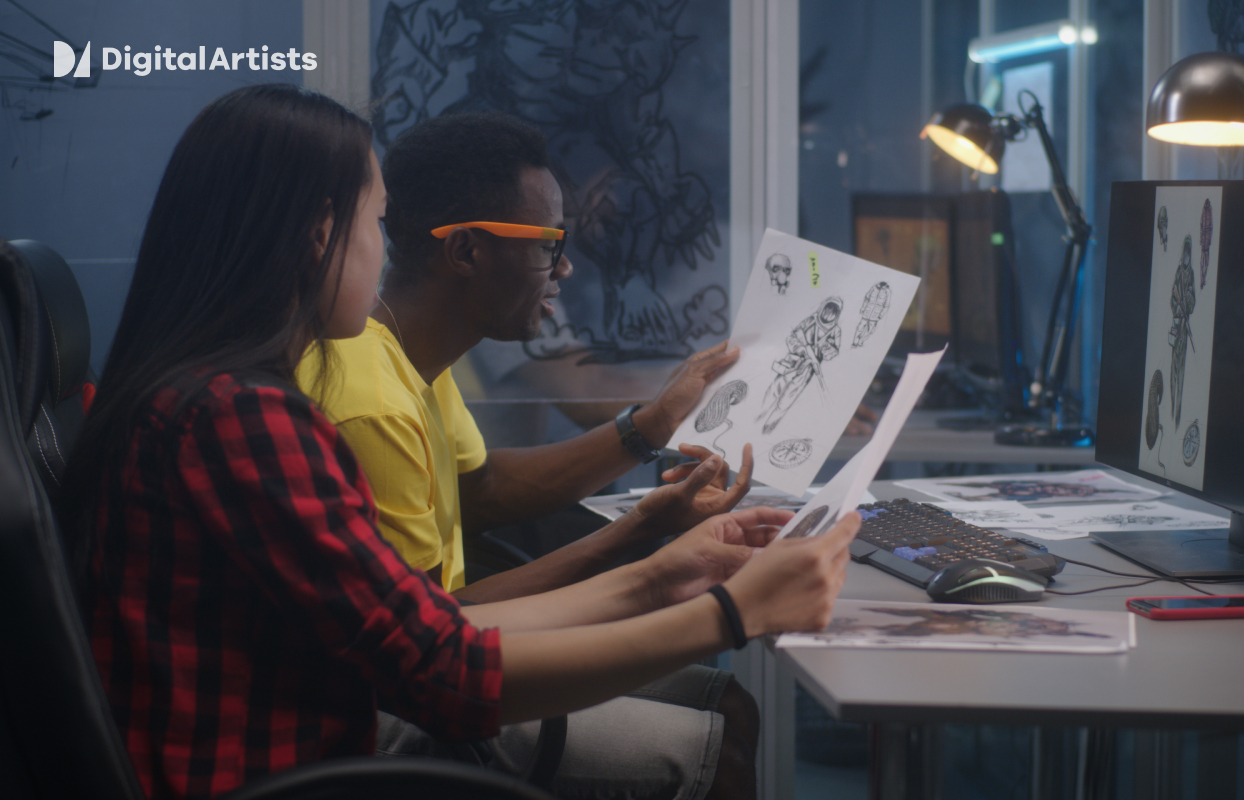


As NFTs are gaining popularity in the crypto and artworld, more and more people develop interest about them. Some see it as a way to earn money whilst others oppose that view and see NFTs as pure art. Though everyone new to the NFT creating gig has the same questions. How do these artists create a collection of 1,000 or 10,000 NFTs? You might think they sit down, grab their iPad and start drawing away, artwork after artwork.
The secret is – most people use an NFT generator. If you don’t have any coding experience, you want your own NFT collection and want it done fast and easy, then this method is the one for you. An NFT generator will help you to receive your collection within minutes. But it will also generate the amount of NFTs that you want in a random shuffle that even you might not come up with if you were to hand draw each of them.
There are still collections out there that are generated through coding. For that you’ll need a couple of coding software on your computer. You’ll also have to go through numerous tutorials to get the hang of it, if you don’t have any coding experience that is. You might eventually spend hours in signing up to different sites, downloading software, writing the code, minting the NFT and finally have it all done.
Not convinced? There’s another way. An NFT Art Generator is a software that, well, generates NFT art. The majority of NFT art projects are based in collections of hundreds, if not thousands of artworks with the same concept but in different styles. For example, you have a collection of bored apes with different accessories on, different facial features and many other things that make each NFT stand out from the rest.
You can now preview your entire collection before starting the generation!#NFT #NFTTool #nftart #NFTartist pic.twitter.com/ujOSQZKif6
— NFT Art Generator (@NFTArtGenerator) February 1, 2022
When the generator is creating the NFT art, it takes into consideration many specifications set by the creator through the project settings. It also shuffles through a lot of possible combinations between available backgrounds (colours), face features, accessories and many more. Once you’ve got all the base-artwork for that, your NFTs are generated within minutes, and you can simply download them and start minting away. That makes an NFT generator the best tool for creating your new collection.
Technology is advancing with each new sunrise and NFT creators are thriving off that. There are numerous NFT generators out there that can help you with your new ideas. One of the most used ways to generate NFTs is through a typical NFT collection generator. Another very popular NFT generator is an AI art generator. With just a single text prompt you can receive a one-of-a-kind artwork. And finally, there’s the animated NFT generator. With the use of that type of generators and editing software, one can also generate animated NFTs, bringing the still artwork to life.
One of the best-known art generators is NightCafe Creator. With a single text prompt, this NFT art generator can provide you with an artwork you could not imagine. For example, we used the prompt a writer sitting on a desk and writing an article and received exactly that . Another prompt that created some inspired visuals was coins raining from the sky in a purple galaxy with candles for stars. Quirky, but visually comforting.
Summer '68. ☀️
— NightCafe Studio (@NightcafeStudio) July 10, 2023
Photorealism has got to be one of our favorite genres of AI creation. 🤩#AIgeneratedimages created using SDXL 0.9 on #NightCafe
🌃 Prompt in alt pic.twitter.com/y0UIGzCdGh
The whole process lasted a minute and we already had two NFTs which we own and could download immediately. NightCafe, like many other software, includes different styles of creation methods like artistic. They have also integrated DALL-E 2 in their website, which is another famous text-to-image generator. This type of generators use credits to generate artworks for you. But you can either receive free credits daily or buy them directly from the website.
You just created one NFT with the AI art generator. But you want a big collection of different NFTs. And here’s where an NFT collection generator would come in handy. The most used one is NFT Art Generator. This website can be used in a couple of easy steps though you need to prepare some basic groundwork for it. After that, you can upload all elements to the generator and set up how often you’d like each of them to show up on your NFTs thus making some of them rare. You don’t need any coding at all and once you’ve hit the generate collection button, you’ll have your zip file downloaded within minutes.
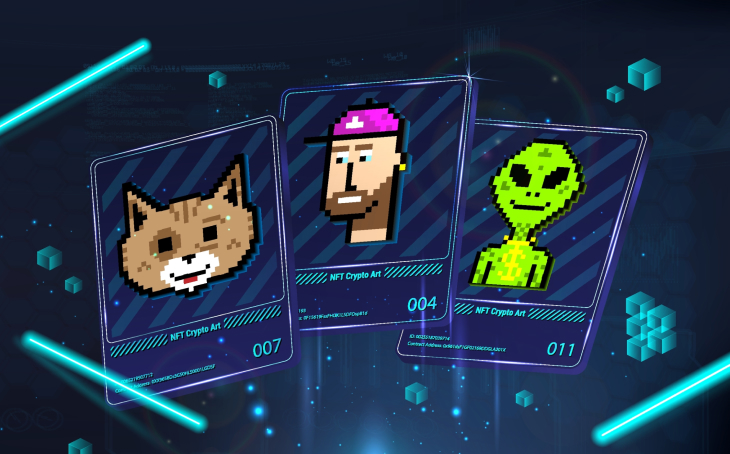
It’s worth mentioning that this option could come with a high cost. After all, you are handed a collection of thousands of randomly generated NFTs with the bare minimum of work. A collection of 1,000 NFTs would cost you $199, 5,000 NFTs for $349 and 10,000 NFTs for $529. Many collections have sold out for a good amount in the past so you could count that as an investment.
If you want to take your NFT collection a notch further, you could use a 3D NFT software to render some amazing animated NFTs. These can either be pictures of 3D objects or short animations of moving objects. You’ll need a 3D modelling software. Patience and willingness to learn will also be required because it is an extensive process for those who haven’t worked with such software. The best part is that you can generate your collection for free.
Blender can help you do so and this is one of the best 3D modelling software. Similar to the NFT collection generator, you can model different elements and then render them in a collection of randomized NFTs. The user interface could be a bit intimidating, being built with a lot of options and tools, but there are plenty of tutorials available on the internet. You could have your first short NFT collection within a couple of hours invested in the process.
Mostly any NFT generator follows the same process. Let’s create our own NFT collection together as an example – we’ll call it Radishilous. Radish and ridiculous mixed together, resulting in a collection of ridiculous radishes. First, we need to design the element artworks of our characters. We need to create every element in the same size. Each PNG also needs to only contain the specific element and have a transparent background. Here’s our list for Radishilous.
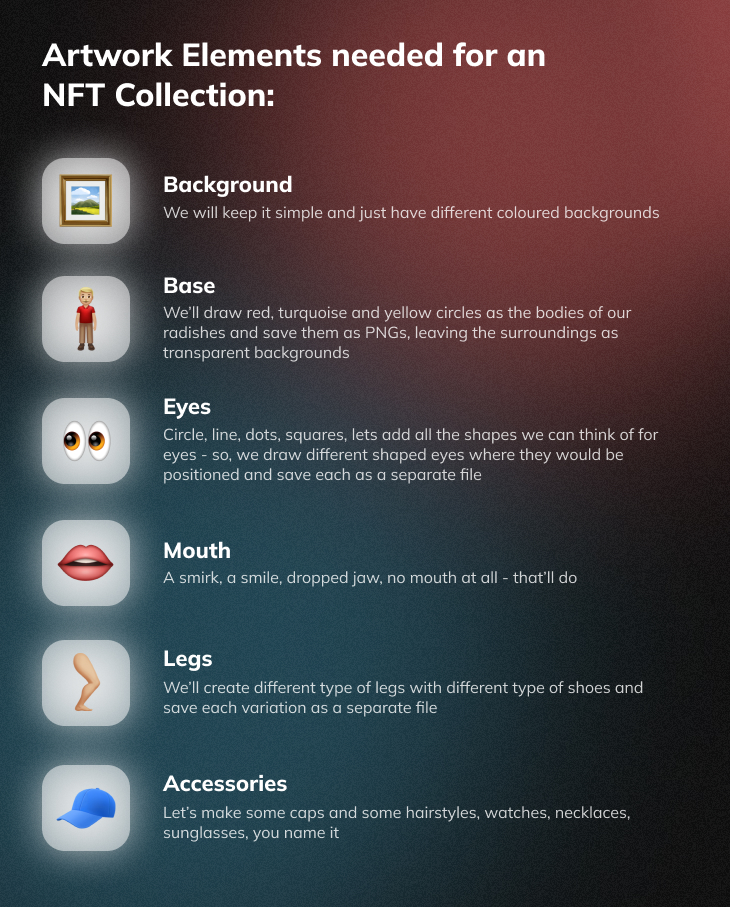
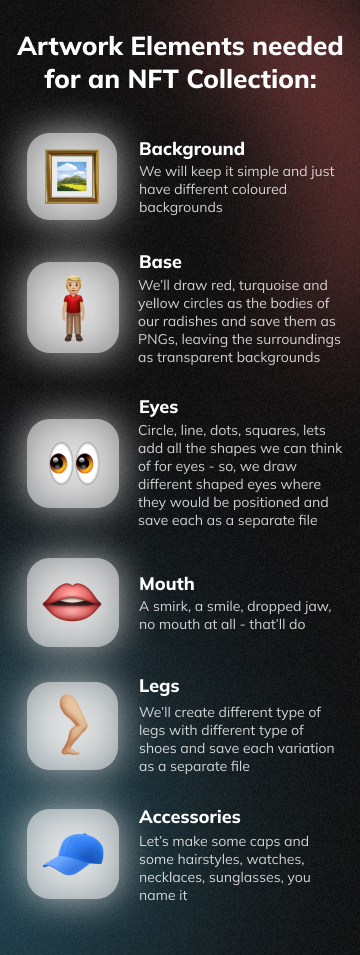
Now that we have more files saved than we imagined in the beginning of the process, let’s generate some NFTs! We’ll open the website/software and create layers. See how our list started with the background and ended with head accessories? Every next layer will be rendered on top of the previous one, so it’s important that your layers don’t overlap. Then we need to set up some percentages. This is important part in the generating process as we have common, uncommon and rare types of NFTs. We can now use the turquoise and yellow base from earlier to create rare NFTs in our big collection.
Set the red base to 96 percent, the turquoise to 2% and yellow to 2%. This means that in a collection of 1,000 NFTs, only 20 radishes will have a yellow body, 20 turquoise and the other 1,960 NFTs will all be red radishes. That percentage scheme can be applied to all other elements, so you can have control on how your collection is being generated. Hit the preview button as many times as you wish to see if it all worked out and then click on generate. You’re all set.
Everything has both positive and negative sides. These could be subjective and maybe you can turn those cons to your benefit. Depending on which type of NFT art software you are using, here’s what to expect:
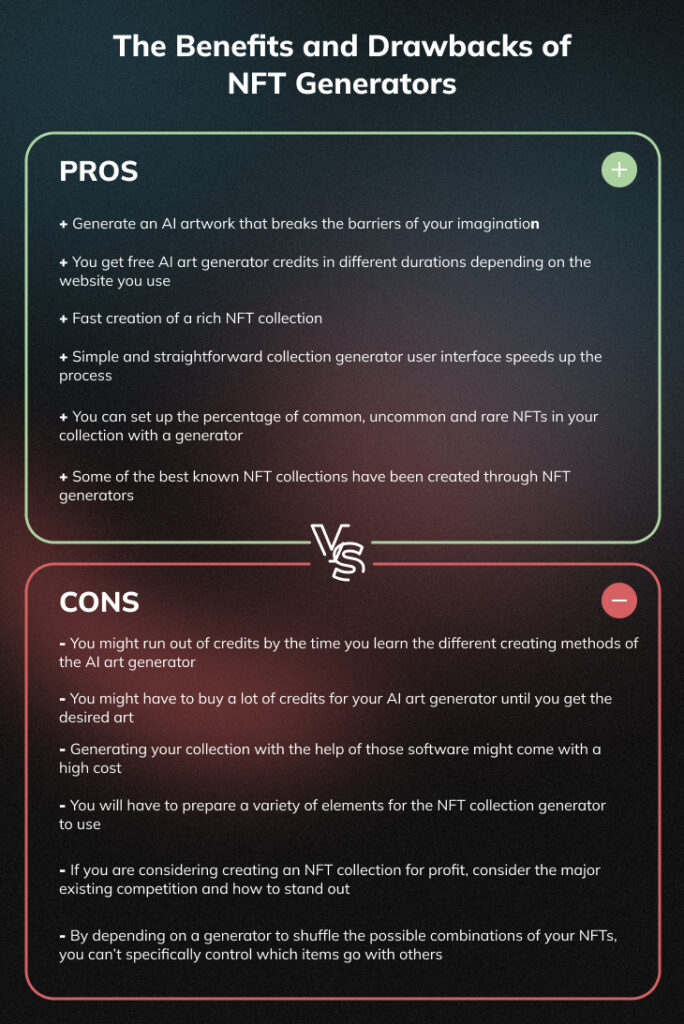

Once you have outweighed the pros and cons, you can deside what works best for your NFT collection. Do you have a clear vision and don’t require as much time and tokens to test out various visuals or are you unaware of what your perfect final products looks like? Do you want to be in control of every aspect of the collection creation, like which items go together and how often, or are you completely open to having randomly surprising product at the end? All of these decisions will help you to prepare for the perfect NFT collection you so desire.
AI generated art can be traced back to over fifty years ago. Even though it consisted of only patterns and algorithms, it was still computer-generated art. It isn’t something that just happened when NFTs became a thing. But it is something that became very popular on social media around NFTs. And that is because nowadays the concept of AI generated art is very advanced. As we already covered, you can just type a text prompt and receive an artwork in seconds. Comparing what AI art used to be back then and to what extent it has developed and is being used nowadays should be deemed eye-opening.
People don’t understand NFTs, Metaverse, and crypto today the same way they didn’t understand online shopping in 1995
Anuj Jasani
An NFT generator nowadays has it all. Or so we think. But the fact that the biggest NFT collections to be minted and sold are created with a generator sets a standard way for future NFT creations. It is easier, and a lot of people choose this path towards success. With that being said and by looking at AI art’s journey, what’s left is for us to wait and see if NFT generators are truly the future for NFTs.
If extensive blogs are not your thing, then read the following summary. NFT this, NFT that, let’s go over the questions which you might have had:
Yes, and you have a couple of options. You can either generate an AI artwork and mint it as an NFT. Or you can use a software to create your own 3D animated NFT. You can also draft a couple of elements, throw them together in an NFT generator and export a whole collection of different NFTs.
Generating an NFT can be done as easy as just writing a simple prompt. An AI art generator will then provide you with an artwork based on your wish. If you want to generate a whole NFT collection on the other hand, you’d need some basic elements designed and a generator to mix them up together.
If you are using the recommended NFT collection generator, you have different ways to upload your art. The recommended layers’ file extensions for that specific generator are PNG, GIF and MP4. If your files are a software-specific format, check if you can export them with a supported extension.
The maths for how many NFTs you can get isn’t that complicated. You just multiply the number of different types of elements that you have. Radishilous has 5 backgrounds, 3 bases, 7 eye shapes, 2 leg types and 4 mouths resulting in 840 NFTs. For 10,000 NFTs, you’d need 10 layers with 4 types of elements each for example.
The best NFT generator for you is a very subjective thing. Do you need it to create an artwork for fun and once only? Or do you need it to create a whole collection of NFTs. Is your NFT collection animated or not? After answering those questions, a quick internet research will point you in the right direction.